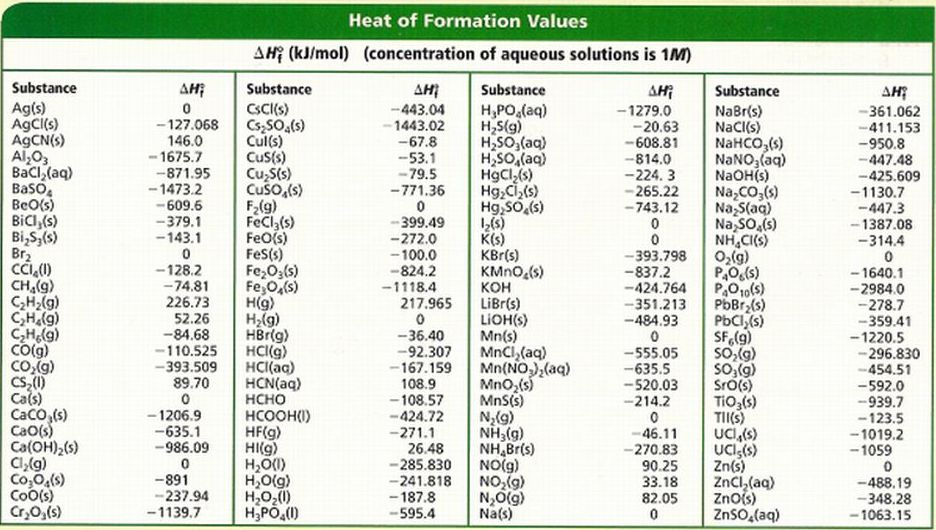Chemistry by OpenStax (2015-05-04)
1st Edition
ISBN:9781938168390
Author:Klaus Theopold, Richard H Langley, Paul Flowers, William R. Robinson, Mark Blaser
Publisher:Klaus Theopold, Richard H Langley, Paul Flowers, William R. Robinson, Mark Blaser
Chapter5: Thermochemistry
Section: Chapter Questions
Problem 50E: How much heat is produced when loo mL of 0.250 M HCl (density, 1.00 g/mL) and 200 mL of 0.150 M NaOH...
Related questions
Question
Use your table of Heats of Formation to calculate the heat of reaction for the following reaction:
Zn + SO2(g) + O2(g) ⟶ ZnSO4(aq)

Transcribed Image Text:Heat of Formation Values
AH (kJ/mol) (concentration of aqueous solutions is 1M)
Substance
AH;
Substance
AHI
-443.04
-1443.02
Substance
AH
-1279.0
-20.63
-608.81
-814.0
-224. 3
-265.22
-743.12
Substance
AH?
Ag(s)
AgCl(s)
AGCN(s)
Al,03
Bacl, (aq)
BasO,
BeO(s)
BiCl,(s)
Bi,S,(s)
Br2
CSCI(s)
Cs;SO,(s)
Cul(s)
Cus(s)
Cu S(s)
Cuso,(s)
F,(g)
FeCl,(s)
FeO(s)
Fes(s)
Fe,O;(s)
Fe,0,(s)
H(g)
H,PO,(aq)
H,S(g)
H,SO,(aq)
H,SO,(aq)
HgCl,(s)
Hg,Ci,(s)
Hg,S0,(s)
NaBr(s)
NaCi(s)
NaHCO,(s)
NANO,(aq)
NaOH(s)
Na,Co,()
Na S(aq)
Na, So,(s)
NH,CI(S)
O,(g)
P,0,(s)
P,O10(s)
PbBr (s)
PbCl,(s)
SF,(g)
So,(g)
So,(g)
Sro(s)
Tio,(s)
TII(S)
UCI,(s)
UCI,(s)
Zn(s)
ZnCl, (aq)
Znočs)
ZnSO,(aq)
- 127.068
146.0
- 1675.7
-871.95
-1473.2
-609.6
-379.1
-361.062
-411.153
-950.8
-447.48
-425.609
-1130.7
-447.3
- 1387.08
-314.4
-67.8
-53.1
-79.5
-771.36
-399.49
-272.0
-100.0
-824.2
K(s)
KBr(s)
KMNO,(s)
кон
-143.1
-128.2
-74.81
226.73
52.26
-84.68
-110.525
-393.798
-837.2
-424.764
-351.213
-484.93
CH,(g)
CH2(g)
CH(g)
C,Helg)
Colg)
Co,ig)
Cs,()
Cals)
CaCo,(s)
CaO(s)
Ca(OH),(s)
Cl,(g)
Co,0,(s)
Coo(s)
Cr,0,(s)
- 1640.1
-2984.0
-278.7
-359.41
- 1220.5
-296.830
-454.51
-592.0
-939.7
-123.5
-1019.2
-1059
-1118.4
217.965
LiBr(s)
LIOH(s)
Mn(s)
MnCl,(aq)
Mn(NO,),(aq)
Mno,(s)
MnS(s)
N,(g)
NH;(g)
NH,Br(s)
NO(g)
NO,(g)
N,O(g)
Na(s)
(6)H
HCI(g)
HCI(ac)
HCN(aq)
HCHO
HBr(g)
-36.40
-92.307
-167.159
108.9
-108.57
-424.72
-271.1
-555.05
-635.5
-520.03
-214.2
-393.509
89.70
- 1206.9
-635.1
-986.09
HCOOH(I)
HF(g)
HI(g)
H,O(1)
H,O(g)
26.48
-285.830
-241.818
- 187.8
-595.4
--46.11
-270.83
90.25
33.18
-891
-237.94
-488.19
-348.28
-1063.15
82.05
-1139.7
H;PO,(1)
Expert Solution
This question has been solved!
Explore an expertly crafted, step-by-step solution for a thorough understanding of key concepts.
This is a popular solution!
Trending now
This is a popular solution!
Step by step
Solved in 3 steps

Knowledge Booster
Learn more about
Need a deep-dive on the concept behind this application? Look no further. Learn more about this topic, chemistry and related others by exploring similar questions and additional content below.Recommended textbooks for you

Chemistry by OpenStax (2015-05-04)
Chemistry
ISBN:
9781938168390
Author:
Klaus Theopold, Richard H Langley, Paul Flowers, William R. Robinson, Mark Blaser
Publisher:
OpenStax

Principles of Modern Chemistry
Chemistry
ISBN:
9781305079113
Author:
David W. Oxtoby, H. Pat Gillis, Laurie J. Butler
Publisher:
Cengage Learning

Chemistry: The Molecular Science
Chemistry
ISBN:
9781285199047
Author:
John W. Moore, Conrad L. Stanitski
Publisher:
Cengage Learning

Chemistry by OpenStax (2015-05-04)
Chemistry
ISBN:
9781938168390
Author:
Klaus Theopold, Richard H Langley, Paul Flowers, William R. Robinson, Mark Blaser
Publisher:
OpenStax

Principles of Modern Chemistry
Chemistry
ISBN:
9781305079113
Author:
David W. Oxtoby, H. Pat Gillis, Laurie J. Butler
Publisher:
Cengage Learning

Chemistry: The Molecular Science
Chemistry
ISBN:
9781285199047
Author:
John W. Moore, Conrad L. Stanitski
Publisher:
Cengage Learning

Chemistry: Principles and Reactions
Chemistry
ISBN:
9781305079373
Author:
William L. Masterton, Cecile N. Hurley
Publisher:
Cengage Learning

Chemistry: Principles and Practice
Chemistry
ISBN:
9780534420123
Author:
Daniel L. Reger, Scott R. Goode, David W. Ball, Edward Mercer
Publisher:
Cengage Learning

Chemistry
Chemistry
ISBN:
9781305957404
Author:
Steven S. Zumdahl, Susan A. Zumdahl, Donald J. DeCoste
Publisher:
Cengage Learning